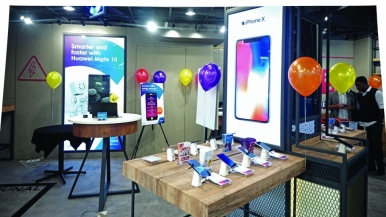Telecommunications giant Celcom Axiata is still going strong in a challenging market, says its deputy CEO Azwan Khan Osman Khan

Tell us more about yourself and your role at Celcom.
In 2005, I joined Celcom as chief strategy officer, when we were still part of Telekom Malaysia. After de-merging from TM in 2008, the cellular and international businesses became what is now the Axiata Group. I moved there as group chief strategy officer, and stayed in my role for five years. I then moved to Sri Lanka as Group Chief Operating Officer for Axiata’s Sri Lankan entities, and in 2016, I rejoined Celcom as Deputy Chief Executive Officer. I run the revenue line directly and make sure that the numbers come in.

How has the journey been so far?
It has been great! Celcom as a company has had its shares of ups and downs. Things were looking down when I first joined in 2005. I was part of the team that managed to turn the company around, and we had many years of excellent growth. When I rejoined in 2016, however, we had lost subscribers and revenue, falling to third place among the major telecommunications providers in Malaysia. Things took a turn for the better last year, where we’ve had a good run and grown the market share, and are back to our #2 position.
How have mobile consumer trends changed in the last few years?
Clearly, the big change in the past decade has been the switch from voice to data. The average consumption per person is now 8GB of data on mobile. We recognise that a lot of it is on video, so we introduced services like Video Walla, which gives our users huge access to pure video content.
The consumers of today also expect network quality to be better than ever, so we are consistently investing in that. What matters is consistency, and we believe in providing an excellent and consistent experience, no matter where you are in the country. Although video and data are the current trend, we’re still trying to anticipate how we can be more relevant to customers going forward.
Another aspect that has changed is customer experience. Gone are the days when you can purely rely on putting base stations and expect people to subscribe to you. Consumers today have much higher expectations. There are those who want pure online interaction, but there are also segments who prefer coming into a customer service branch and talking to someone face-to-face. This is why we’re embarking on a strong omni-channel experience. We’ve revamped our website to be more user-friendly, and improved on our app, to give people the freedom to choose how they want to interact with us, and we will continue to focus on providing the best customer experience.
Celcom recently launched several lifestyle offerings. How does this tie in to your services?

I strongly believe that as a telco, we have to go beyond providing pure telecommunications services. The type of products that we have launched recently, such as our Celcom First plans, really takes us beyond that. When you sign up with us, you can choose to redeem free one-off return flight tickets to any destination in ASEAN, or monthly movie tickets from Golden Screen Cinemas, discounts for the ride-sharing app Grab, drinks from Tealive, and more.
How do you choose which companies to partner with?
We look at market trends and make sure that we’re providing things that are relevant to people’s lifestyles. For example, there are more people using ride sharing these days, so we partnered with Grab to provide discounts to users who use the app. In terms of leisure and entertainment, Malaysians are avid moviegoers, so we partnered with Golden Screen Cinemas to provide users with free movie tickets monthly.
One of the things that we do very well, both at Axiata and at Celcom, is partnerships. Many people don’t realise that we were the first to open our doors to Mobile Virtual Network Operators, such as TuneTalk, RedOne, Merchantrade and XOX since 2008, where they ‘ride’ on our network but are essentially an independent operator. We also have a strong partnership with Digi, another major Malaysian telecommunications operator. Despite being competitors on the retail front, we work together on building infrastructure and connectivity. Our view is quite simple. It doesn’t make sense to try and reinvent the wheel, so we partner with whoever is best in the business.
What are some of the current challenges in the industry?
Data pricing is an issue. Companies are giving away more data for less. On the surface, that’s a good thing for consumers, but what we do not like is fine print. There would be packages that promise a large amount of data, but only a set amount can be used on the weekend, or weekdays, or on certain platforms.
One of the first things that I did when I came in as Deputy CEO was to simplify our packages. In December 2016, we launched our prepaid XPAX #NoKelentong, to get away from all that. What you see is what you get.
Broader challenges in the industry would include capital expenditure. We spent RM1.5 billion (USD 383 million) in capex in 2017, even though industry revenues were flat.
Why are revenues not improving?
Hyper-competition. Typically, most markets in the world consist of three big players that are profitable. Even India, for example, used to have nine to ten telecommunication players, but smaller ones are consolidating because they are unprofitable.
In Malaysia, we have three major players and two smaller players. If you’re a small entity and you’re losing money, the only way to compete is by price, which effectively brings down market revenues overall. From our point of view, we are very clear that we will not fight in a price war. Our products will be the best in value and overall customer experience, but not necessarily be the cheapest.
Celcom has consistently invested in improving 4G coverage nationwide. What does this entail?
Celcom currently has the strongest rural coverage in the country, especially on 2G, while our 4G is on par. Revenue from some of these obscure sites is low, but having said that, these are the places where you are most likely to need coverage if you run into trouble. A lot of our 4G investment also involves increasing coverage and bringing a good broadband experience to rural areas.
Profitability matters, but as a company, our purpose is to build awesome moments and bring great experiences to people. In the broadest sense, we hope to open up worlds beyond telecommunications. Our lifestyle offerings, for example, have nothing to do with a telco product. It’s about the holistic awesomeness of being a Celcom user.
What plans are in the pipeline for 2018?
We will continue to invest heavily in improving our network, to ensure we are the top, undisputed 4G network in Malaysia.
Customer experience will also be our top priority. We use Net Promoter Score surveys to gauge and improve on our services. Customers are asked to rate us from a scale of 0-10, and how likely they would recommend us to friends or family. Even our partners, such as our dealers, get surveyed, which is a radical shift in our mindset, where we ask them to judge us.
Another side we are looking into is digitisation. This includes simplifying the business using IT, and adopting a digital mindset. If a user wants to sign up with us, they can come online, key in their details, and we will deliver a SIM card right to their doorstep. If they want to top up their prepaid cards, we’ve got digital apps that can be paid for through online transactions with a simple click.
Since September 2016 with the new management team, we’ve done a lot to simplify processes and change the internal culture and mindset of the company. Things were somewhat bureaucratic in the past, but they’ve gotten better. Most importantly though, we are increasingly obsessed with providing the best end-to-end customer experience as our core strategy. By that I don’t mean customer service alone, but everything, including the product, network, the sign-up or registration experience, everything; End to end. We hope that with all these strategies in place, we can look forward to a strong 2018.





